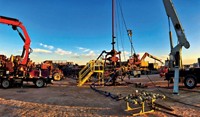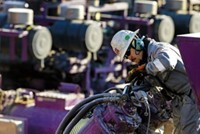Advertisement
Grab your lab coat. Let's get started
Welcome!
Welcome!
Create an account below to get 6 C&EN articles per month, receive newsletters and more - all free.
It seems this is your first time logging in online. Please enter the following information to continue.
As an ACS member you automatically get access to this site. All we need is few more details to create your reading experience.
Not you? Sign in with a different account.
Not you? Sign in with a different account.
ERROR 1
ERROR 1
ERROR 2
ERROR 2
ERROR 2
ERROR 2
ERROR 2
Password and Confirm password must match.
If you have an ACS member number, please enter it here so we can link this account to your membership. (optional)
ERROR 2
ACS values your privacy. By submitting your information, you are gaining access to C&EN and subscribing to our weekly newsletter. We use the information you provide to make your reading experience better, and we will never sell your data to third party members.
Environment
Industry Creates A Forum To Improve Fracking’s Environmental Footprint
Collaboration: Hydraulic Fracturing Roundtable aims to guide research on more sustainable practices and to effectively communicate progress to the public
by Stephen K. Ritter
December 11, 2014
SOURCE: William Stringfellow

SOURCE: William Stringfellow
Companies within the hydraulic fracturing industry have joined forces with the American Chemical Society’s Green Chemistry Institute (GCI) to create a forum aimed at making oil and gas extraction processes more efficient and reducing their environmental footprint.
The new group, GCI’s Hydraulic Fracturing Roundtable, will provide a means for member companies to collaboratively prioritize chemical and engineering research needs to improve fracking methods and help manage current and long-term environmental impacts from this extraction method. A key goal is to glean the most economic benefit from the technology.
In particular, the scientific collaboration will take a closer look at chemicals commonly employed in hydraulic fracturing and work toward developing more environmentally benign and sustainable alternatives.
The founding roundtable members include oil and gas exploration and production companies Apache and Marathon Oil, gas- and oil-field services companies Rockwater Energy Solutions and Trican Well Service, water treatment services firm Nalco, and chemicals giant Dow Chemical. Other companies are expected to join the roundtable over time.
The roundtable will draw on resources from the Environmental Protection Agency’s Design for the Environment and Green Chemistry programs and the Society of Petroleum Engineers working group on safer chemicals, among others. The group will be an addition to GCI’s roundtables for the pharmaceutical industry, chemical formulators that make household cleaning and personal care products, and commodity chemical manufacturers.
“It is important to bring third-party credibility, sound science, and good research to this whole area of hydraulic fracturing,” says David Long, president of consulting firm Environmental Sustainability Solutions, who is a GCI governing board member and cochair of the fracking roundtable. “The roundtable offers a way for competitive companies to come together and work collaboratively to use green chemistry to address common noncompetitive issues and research needs.”
“Green chemistry is also safer chemistry,” adds Apache’s Danny Durham, a cochair of the new group. “The roundtable will focus on improving the environmental footprint of the industry by funding academic research for safer alternatives, sharing scientific information, developing tools that help operators make good choices, and communicating the facts with key stakeholders.”

Hydraulic fracturing, commonly called fracking, is a drilling process in which a mixture of about 90% water and 10% proppant (sand or a granular ceramic material) is injected underground to release hydrocarbons locked in shale and other rock formations. The fracking fluid typically contains less than 1% of an assortment of chemical additives customized for each well to optimize oil and gas production.
These additives include gelling agents to thicken the fluids, corrosion inhibitors to protect pipes, and biocides to keep microbes from fouling wells. Few of the roughly 90 commonly used compounds are toxic to people, according to a recent study, but there’s still insufficient information communicated by the oil and gas industry for the public to fully evaluate the safety of the chemical additives (C&EN, Aug. 18, page 7).
Fracking has taken the U.S. by storm over the past decade and turned into a bonanza for oil and natural gas companies. Despite the success, a range of environmental concerns have emerged to plague the industry. These include hazards from the chemical additives, well construction issues leading to leaky casings that can contaminate groundwater, the use of millions of gallons of water and the generation of large volumes of wastewater, and emissions of methane and other hydrocarbons to the atmosphere.
To address these concerns, the new roundtable’s members will look at practices to reduce overall chemical volume, emissions of volatile organic compounds, and toxicity by selecting compounds that are less bioaccumulative and more biodegradable.
For example, Trican is developing a bacterial lipopeptide with surfactant properties as a low-toxicity biocide for controlling nuisance bacteria. And Dow supplies an acrylic coating for fracking sand that helps improve fluid performance and reduces worker exposure to lung-damaging silica dust.
“Given the high level of public concern about chemicals used in hydraulic fracturing, moving toward chemicals with less toxicity cannot only reduce business risks and save money, but can also enable hydraulic fracturing companies to speak directly to the public’s concern,” says Richard A. Liroff, executive director of the Investor Environmental Health Network, an advocacy group that helped facilitate the roundtable’s formation.




Join the conversation
Contact the reporter
Submit a Letter to the Editor for publication
Engage with us on Twitter